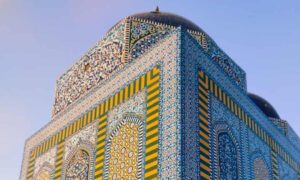
The small city of Nasarpur in Pakistan has a centuries-old reputation for its ceramics. That’s why, when the ceramic worker Ghulam Hyder Daudpota decided to come all the way to London to master his craft, he says “it seemed futile”. But, he adds: “It turned into a life-changing opportunity.”
Daudpota grew up with eight siblings in a city where the mosques and shrines are embellished with terracotta and blue glazed tiles, known as the art of kashikari. He spoke little English until the age of 27 and his parents had “no deep pockets” to pay his tuition fees.
But the talented Pakistani secured a full scholarship at the King’s Foundation school of traditional arts (KFSTA) in east London, before returning to his country and helping to revive the dying craft.
“Kashikari is ubiquitous across [the province of] Sindh, but when I was growing up it was considered a dying craft and only a few craftsmen were practising. If it wasn’t for my time at KFSTA, I wouldn’t be where I am at the moment,” Daudpota says from his Nasarpur workshop, which now employs 40 people.
Believed to have originated in the Iranian city of Kashan, kashikari involves making biomorphic patterns on terracotta clay by dabbing graphite on perforated paper, before applying turquoise metallic pigments found in copper and cobalt oxides.
